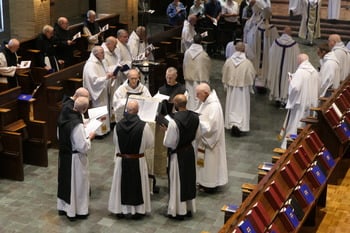-
August 8, 2025By Maria Young | The Catholic Free Press
SPENCER – The Trappist monks of St. Joseph’s Abbey live a contemplative life of prayer and work – and they have been doing so for 200 years – 75 of those years in the town of Spencer.
On Aug. 1, a Jubilee Mass was celebrated on the 50th anniversary of the dedication of the Abbey church.
Bishop McManus celebrated the Mass that was attended by Bishop Richard F. Reidy of the Diocese of Norwich, Abbot Vincent Rogers of the Cistercian Order of the Strict Observance commonly called Trappists, many Trappist monks and priests from the Worcester diocese, as well as family, friends and benefactors of the community.
All three significant anniversaries fall during the universal Church’s Jubilee Year of Hope.
“It is comforting to think that Jubilee 2025 will coincide with our own jubilee of 200 years since the foundation of our community,” says a reflection by the monastery’s head, Abbot Rogers.
“How many times did our fathers of Spencer have to renew their hope that God had a plan and purpose for their community, despite all the fires, despite the hardships of Trappist life. In hope, they believed against hope – moving from Nova Scotia to Rhode Island to Spencer – that there was a divine purpose for their life.”
While their origins date back to the 11th century, this particular religious community of cloistered Roman Catholic monks of the Cistercian Order of the Strict Observance was founded in 1825 in Tracadie, Nova Scotia, and remained there until 1900. They moved to Our Lady of the Valley monastery in Cumberland, Rhode Island, that year and remained until 1950, when a fire on March 21 destroyed their abbey, built by the monks themselves. In 1950 they purchased what was then called Alta Crest Farms which became St. Joseph’s Abbey and 80 monks took possession of the space on Dec. 23 that year.
The number of monks grew to 186 by 1957, the abbey website states. Today there are about 50 in the community.
During the Mass at St. Joseph’s Abbey, Bishop Mc-Manus thanked Abbot Rogers for the invitation and called the monastic community at St. Joseph’s Abbey “a treasure.”
He referenced a 2012 address by then Father Robert F. Prevost, now Pope Leo XIV, to the Synod of Bishops in Rome. The future pope stated, “The Church should resist the temptation to believe that it can compete with modern mass media by turning the sacred liturgy into spectacle. ... Our proper mission is to introduce people to the nature of mystery as an antidote to spectacle. As a consequence, evangelization in the modern world must find the appropriate means for redirecting public attention away from spectacle and into mystery.”
“Thank God,” Bishop McManus said, that that mystery of faith is celebrated at St. Joseph’s Abbey where the love of Christ is “made apparent.”
The phrase “prefer nothing to the love of Christ” comes from the Rule of St. Benedict, a basis and guide for the Trappist monks.
Abbott Rogers spoke of the scriptures referring to believers as “living stones” and offering “spiritual sacrifices, adding ours to so many throughout the world today.”
“Our house is set on this solid rock – to Nova Scotia to Rhode Island to Spencer. God has built up this community stone by stone and placed it on the solid foundation of Jesus Christ.”
At the anniversary Mass, the schola, a choir of monks, filled the stone church with beautiful chants dedicated to the glory of God.
The following day St. Joseph’s Abbey hosted an open house to celebrate the 200 years since its community’s founding. Monks gave tours of the cloisters, there was an opportunity to visit a historical display, pray in their guest chapels, and an offering of light refreshments.
Situated on about 2,000 acres of idyllic, green land, St. Joseph’s Abbey seems to be the perfect spot to quietly focus your life – or for visitors, even a few moments – on God.
In their contemplative life, the cloistered monks dedicate themselves to “worship of God in a hidden life within their monastery,” the website explains. “Following Saint Benedict’s sixth century Rule for Monasteries, the monks live in silence and solitude, in prayer and penitence, thus rendering God ‘a service that is at once humble and noble.’ Since the brothers are of one heart and one mind, they have everything in common, for the monastery is a school of love.”
Trappists also live by the work of their hands. “Work has always been greatly esteemed in the Cistercian tradition, since it gives the monks the opportunity to follow in Christ’s footsteps and share in his divine work of creation and restoration,” the website says. “This sometimes hard and redeeming work provides for our own livelihood and for our care of the poor.”
Trappist preserves and the Holy Rood Guild are two of the ways that the monks living in Spencer live by the work of their hands.
Currently at Trappist preserves, 80 jars are produced a minute, according to Brother Daniel Charpentier, monastery prior. They have been producing these all-natural jams, jellies, preserves and conserves since 1954. They can be found at the St. Joseph’s Abbey gift shop, at various local grocery stores and online.
The Holy Rood Guild has been producing vestments for decades. These creations “of beauty and distinction” are made “to fittingly express the reverence, love and devotion which the Church brings to her celebration of the Sacred Liturgy,” the abbey website says.
The gift shop also offers food products from Trappist communities across the country, as well as pottery, printed photography by monks at the Abbey, books, candles, incense, holy cards and more.
Abbey guest chapels are open daily for Mass and prayer beginning at 5:30 a.m. each day. Retreats are also offered.
–For more information visit spencerabbey.org.

